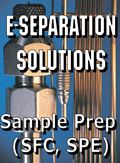Ask the Editor: Chromatographic Methods for Hydrocarbon Analysis in Soil
The exact method used depends upon the type of hydrocarbon contamination in the soil.
A reader recently asked:
What chromatographic methods are used to analyze hydrocarbons in soil?
The exact method used depends upon the type of hydrocarbon contamination in the soil. Different chromatographic methods are used to analyze the volatile and semivolatile components of petroleum hydrocarbon contamination in soil.
Volatiles - the gasoline range organics (GRO) - can be determined by purge-and-trap gas chromatography (GC) with flame ionization detection (FID). Semivolatiles, or diesel range organics (DRO), can be analyzed using an extraction procedure followed by GC-FID. Various extraction procedures can be used, including solvent extraction, Soxhlet extraction, solid-phase extraction, supercritical fluid extraction, sonication extraction, and microwave extraction. FID measures the total hydrocarbon content, and photoionization detection can be used to measure the aromatic compounds. GC with mass spectrometric detection also can be used.
According to LCGC's "GC Connections" editor John Hinshaw, "Laboratory analytical methods as well as field sampling techniques strongly influence volatile organic compound (VOC) selectivities and recoveries from soils. These GC sampling methodologies are the recognized, commonly used ones in the U.S.
"I would add a few more to the list: Equilibrium headspace sampling is a very good alternative to purge-and-trap for the volatile compounds. The amount of added solvents, including organic displacers, can be quite small, and recent headspace samplers have trapping options plus multiple sampling cycles per vial that significantly lower the method detection limits (MDL). Solid-phase microextraction (SPME) provides another means for transferring volatiles from the sample vial to the GC inlet. Another alternative is thermal desorption, which involves heating the soil to release the volatiles, usually in the absence of any additional solvents.
"Each analytical sampling method for GC has its own characteristics that influence the quality of results. Consideration of regulatory requirements along with careful testing and validation with a specific sample matrix and field sampling regimen is the best way to choose a particular methodology."
Questions?LCGC technical editor Steve Brown will answer your technical questions. Each month, one question will be selected to appear in this space, so we welcome your submissions. Please send all questions to the attention of "Ask the Editor" at lcgcedit@lcgcmag.com. We look forward to hearing from you.
Trending on LCGC: The Top Content of 2024
December 30th 2024In 2024, we launched a content series, covered major conferences, presented prestigious awards, and continued our monthly Analytically Speaking podcasts. Below, you'll find a selection of the most popular content from LCGC International over the past year.
